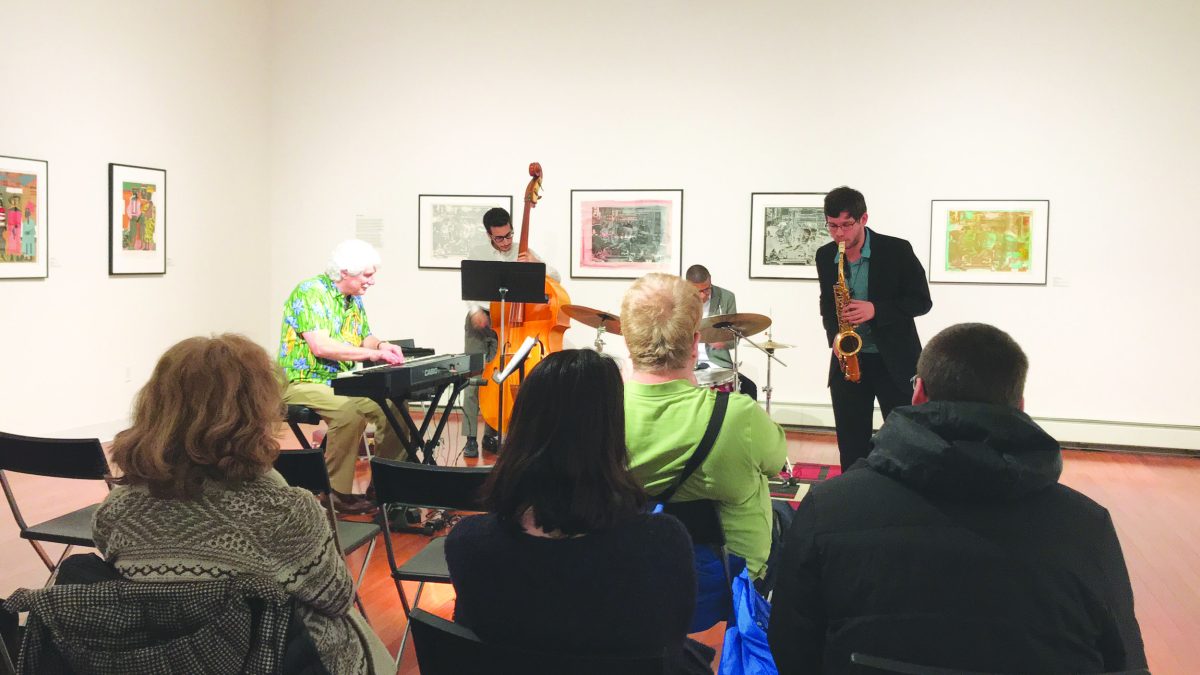To promote the current Hofstra University Museum exhibition, “Romare Bearden: Storyteller,” a student-led jazz quartet performed evening pieces in Emily Lowe Gallery, interspersed by historical context by David Lalama, professor of music.
“Bearden often depicted jazz and blues musicians in his collages and prints,” said Karen Albert, the deputy director and chief curator at the Hofstra University Museum. “Beyond the use of jazz as a subject, he worked in an improvisational style – experimenting with compositional variations within a structure. Listening to music, jazz and the blues in particular, while viewing the Bearden exhibition, enlivens and animates his visual work.”
“He’s definitely as a visual artist completely connected to jazz,” Lalama said.
Composed of Lalama, two current students and a recent graduate, the quartet performed homages to Bearden alongside recitals of famous pieces by bebop musicians like Thelonious Monk.
Pieces performed included “Rhythm-a-Ning,” a jazz composition by Monk, “Ain’t Misbehavin” by Fats Waller and “Carolina Shout” by James P. Johnson.
In between performances, Lalama shared biographical information about Bearden alongside historical context on jazz itself.
When Bearden was growing up, “You had the Harlem Renaissance already going on, and he was drawn to that,” Lalama said. “When he was coming up in the world, jazz was just ending its big popularity in the swing era with the big bands. Then we were getting into the hipper, more artistic version of jazz known as bebop, and that’s Charlie Parker, Dizzy Gillespie and Thelonious Monk.”
Bearden went to high school in Pittsburgh with famous jazz singer Billy Eckstine, who was another musical influence on the artist. “That kind of got him into the music and the fact that it was true African-American heart music,” Lalama said.
“In jazz, particularly in Harlem, there’s this place called Minton’s Playhouse where all the musicians would gather after their gigs, so they were called after hour jam sessions,” he said. “That’s where they were experimenting, and that’s literally where the style known as bebop was born. He was part of that community. Bearden was friends with all the major artists in that art form, particularly the beboppers and particularly Dizzy Gillespie. When he became recognized as the great artist that he is, young African-American jazz musicians began paying homage to Bearden.”
Branford Marsalis, legendary American saxophonist, paid homage to the artist in a quartet album entitled “Romare Bearden Revealed” from which the quartet performed the composition “Seabreeze.”
“A Night in Tunisia,” a jazz standard by Dizzy Gillespie written around 1941, closed out the night. A notoriously difficult composition to perform, the jazz quartet pulled off a dazzling rendition.
Thomas Abdelmalak, the bassist of the quartet and a senior math and math education double major said, “I really loved playing at this event, more so than others on campus. Especially because it’s commemorating an artist whose art was rooted in African-American culture and jazz. And it’s especially great that Hofstra had this exhibition for an artist that most students would not have heard of otherwise, myself included.”
Students attending the event found the conjunction of the performances with Bearden’s pieces enlightening.
Fiona Murray, a sophomore psychology major said, “It’s really cool that Hofstra put this art display and the jazz quartet together. It’s a super great opportunity for music students and others to get involved in different aspects of campus, because it was evident that a lot of work went not only into the jazz quartet, but to the art exhibit itself. The musicians were all very talented, and I’d love to see Hofstra do these type of engaging collaborations on campus more, especially with the museum because it was actually the first time I’d been in the Emily Lowe Gallery.”







